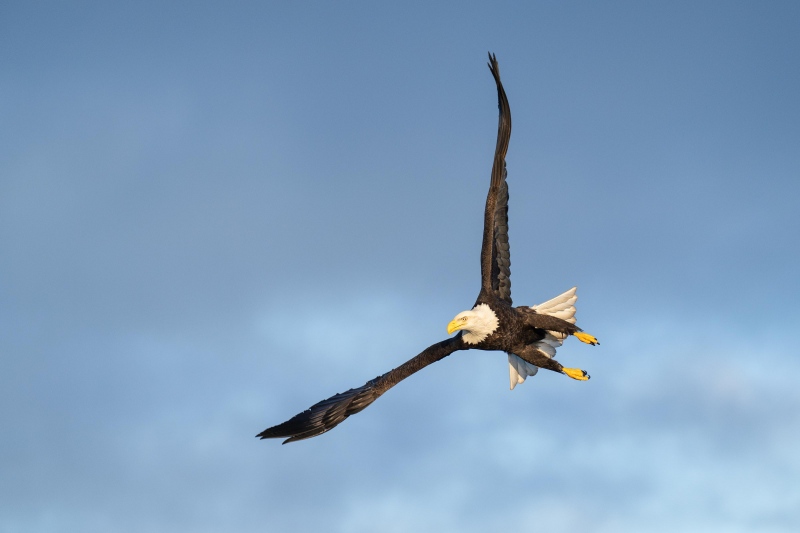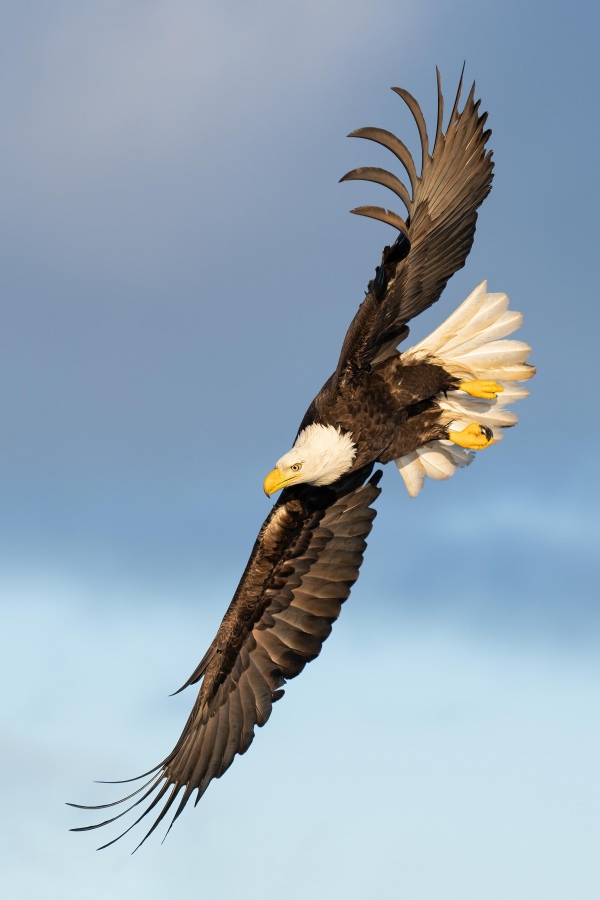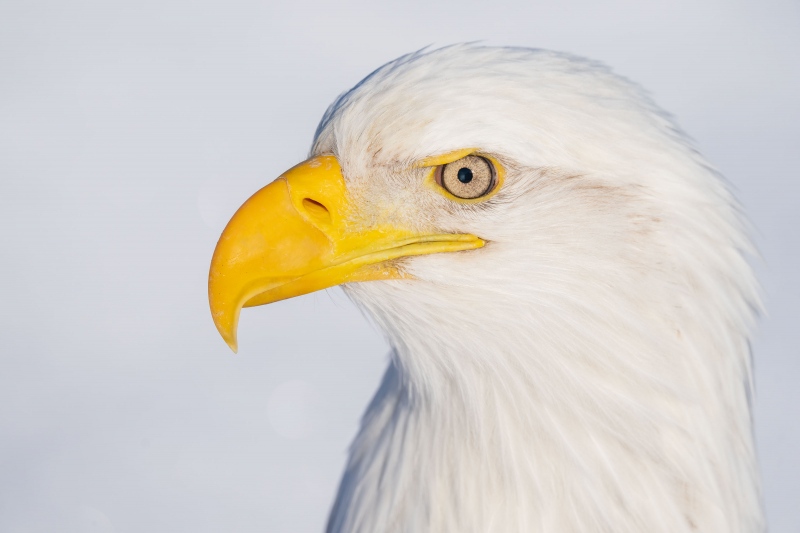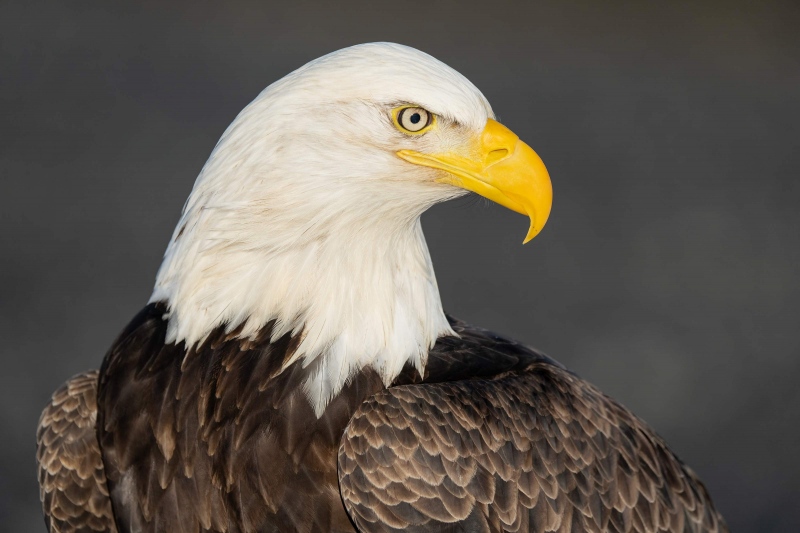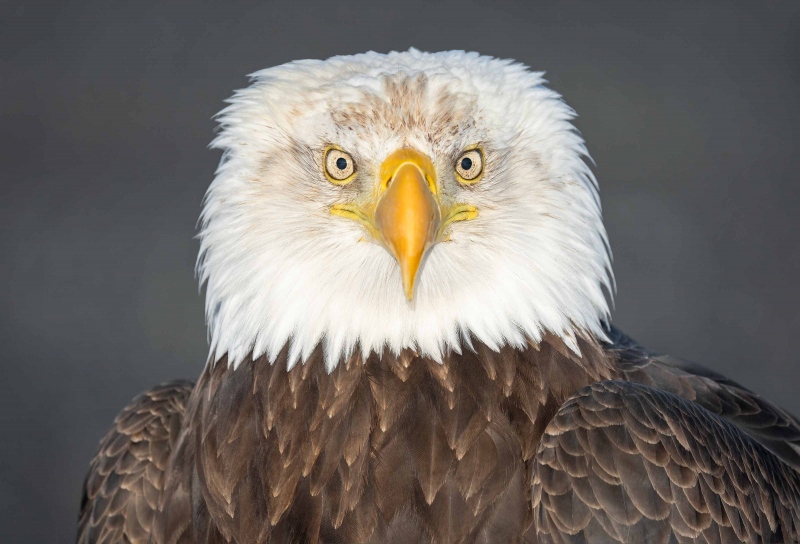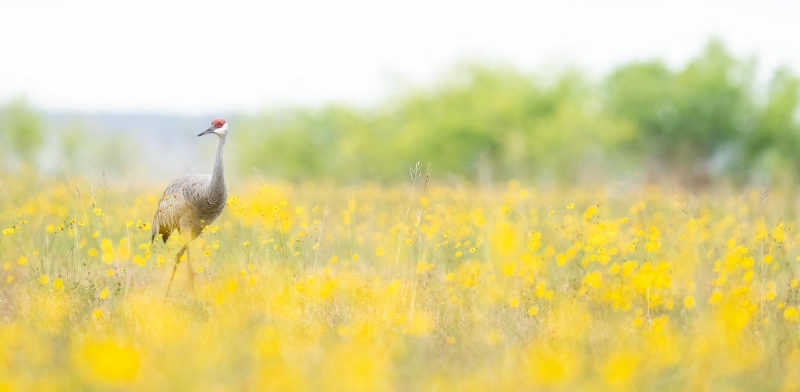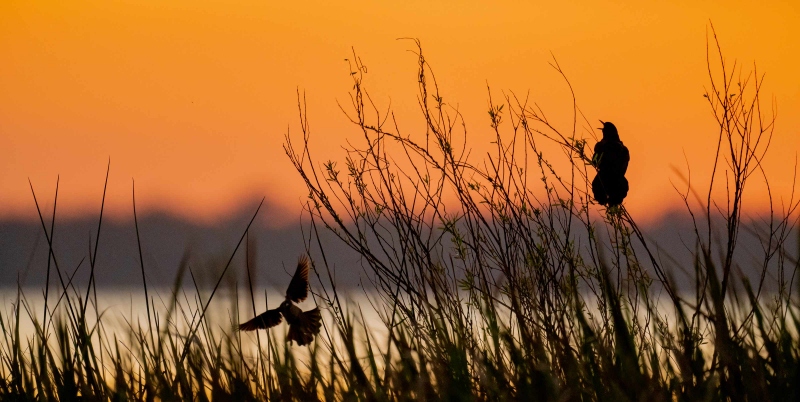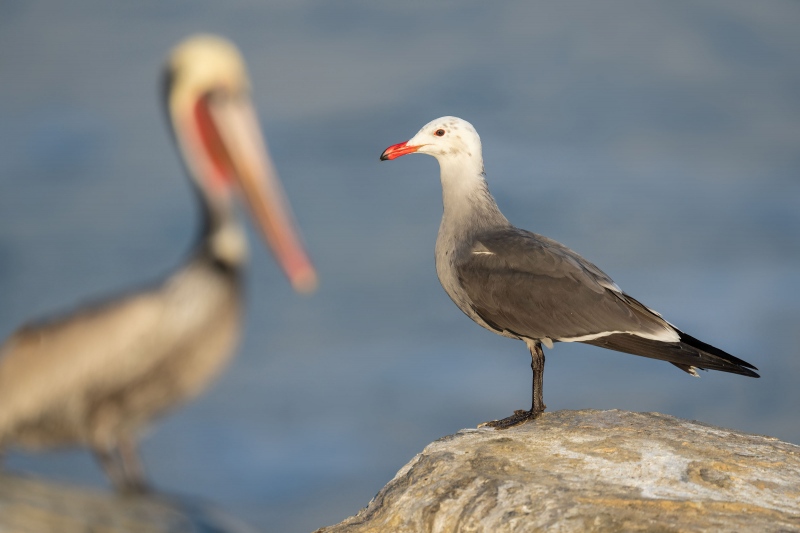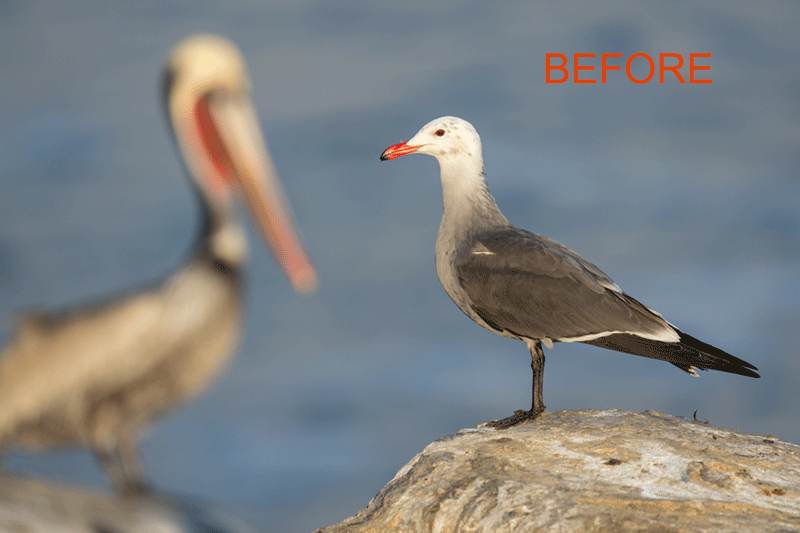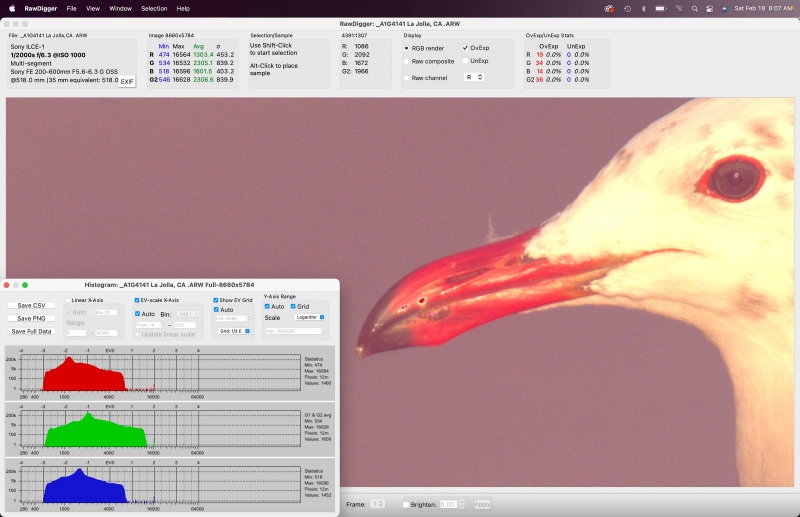February 21st, 2023 Your Call?
Which of today’s five, all very excellent images is your absolute favorite? By participating, you will actually learn a lot. If you do leave a comment, please let us know why you made your choice. If anything in any of the images bugs you, let us know that too.
What’s Up?
The first morning of the first 2023 Homer Bald Eagle IPT got off to a very good start. Keep reading to learn of our good fortune.
In yesterday’s blog post, Image #2, for me, was the worst of the lot by far. Even though I eliminated a lot of clutter during image clean-up, the image was still messy. (Not Lionel). My favorite was the crane in the tickseed blossoms. The main reason that I went to manual focus was as follows: when the crane lowered its head to feed, AF had no chance. Using Focus Peeking with a total depth of field of more than two meters on the relatively distant subject, I knew that I would have no problem getting the crane sharp. Some folks were in the vicinity of the correct answer to the “Why manual focus? question.”
Today is Tuesday 21 February 2023. We will be meeting our captain and mate at the dock at 8:15am. The forecast is for partly cloudy skies Turning completely cloudy early with a barely perceptible breeze from the northeast. The temps will be in the low 20s F, a bit warmer than yesterday.
If you have some cold weather gear, are free from about 23 or 24 February through March 3 or 4, and would like to join the second Homer IPT, please get in touch via e-mail ASAP as I am practically giving that one away for free.
This blog post took about three hours to prepare (still on Florida time, I get up very early!) including the time spent on the five image optimizations and makes three hundred twenty-eight days in a row with a new educational post written just for you. Wherever you are and whatever you are doing, I hope that you too have a great day.
Please, please, pretty please remember to use m B&H or Bedford’s affiliate programs for all your new gear purchases. If you use B&H, please be sure to click on any B&H link in the blog to start your search. Or simply start with this link. There is always the option of e-mailing me for gear advice and for the correct links.
The plan is to continue to post every day until the streak reaches one year and one day and then begin posting every other day.
Please remember to use the B&H and Amazon links that are found on most blog pages and to use the BIRDSASART discount code at checkout when purchasing your new gear from Bedfords to get 3% back on your credit card and enjoy free second-day air FedEx. Please, also, consider joining a BAA IPT. You will be amazed at how much you will learn!
You can find some great photo accessories (and necessities, like surf booties!) on Amazon by clicking on the Stuff tab on the orange/yellow menu bar above. On a related note, it would be extremely helpful if blog-folks who, like me, spend too much money on Amazon, would get in the habit of clicking on the Amazon logo link on the right side of each blog post when they shop online. As you might expect, doing so will not cost you a single penny, but would be appreciated tremendously by yours truly. And doing so, works seamlessly with your Amazon Prime account.
Please remember that if an item — a Delkin flash card, or a tripod head — for example, that is available from B&H and/or Bedfords, is also available in the BAA Online Store, it would be great, and greatly appreciated, if you would opt to purchase from us. We will match any price. Please remember also to use my B&H affiliate links or to earn 3% cash back at Bedfords by using the BIRDSASART discount code at checkout for your major gear purchases. Doing either often earns you free guides and/or discounts. And always earns my great appreciation.
|
|
|
This image was created on 20 February 2023 on an Instructional Photo-Tour at Kachemak Bay, Homer, AK. I used the hand held Sony FE 70-200mm f/2.8 GM OSS II lens with the Sony FE 1.4x Teleconverter (at 186mm) and The One, the Sony Alpha 1 Mirrorless Digital Camera.. The exposure was determined via Zebras. ISO 800: 1/3200 sec. at f/4 (wide open) in Manual mode. AWB at 9:22:05am on a sunny morning.
Tracking: Expand Spot AF/C with Bird-Eye/Face Detection performed perfectly. Click on the image to enjoy a high-res version.
Image #1: Bald Eagle adult turning left in flight
|
A Sunny Morning!
Sunny days are a rare commodity in Homer in winter. With the clear skies, we left the harbor early on Monday. The breeze was from the northwest but was very slight. So, some birds slightly away from us while other flew right at us. The group was totally amazed as we had as many as three dozen eagles in the air at once, with many dozen more taking a break on the beach at low tide. After our long working brunch, we had time only for a short rest before heading for what we had hoped would be a sunset silhouette session. When we exited Land’s End we were smacked by a strong northwest wind and the temps had seemingly dropped by 20°. My cell rang; it was Captain Gabe. Our afternoon session was cancelled because of high winds with 8-foot waves. We retired to the bar and did a lengthy image review session. The group is really into learning to get better as they asked about a zillion questions during our knockabout meeting.
With Image #1, I took full advantage of the single, large dark cloud just to the south of us (and urged the group to do that same).
|
|
|
This image was also created on 20 February 2023 on an Instructional Photo-Tour at Kachemak Bay, Homer, AK. Again I used the hand held Sony FE 70-200mm f/2.8 GM OSS II lens with the Sony FE 1.4x Teleconverter (this time at 197mm) and The One, the Sony Alpha 1 Mirrorless Digital Camera.. The exposure was determined via Zebras. ISO 1000: 1/3200 sec. at f/4 (wide open) in Manual mode. AWB at 27:47:05am on a sunny morning.
Tracking: Zone AF/C with Bird-Eye/Face Detection performed perfectly. Click on the image to enjoy a high-res version.
Image #2: Bald Eagle adult banking
|
Improving Your Flight Photography
After studying and understanding the principles of flight photography, the next step to success is practice, practice, and practice. On extended flight photography trips folks — including me — cannot help but to see their panning and framing skills improving day by day. During our image review I said this often: Universal advice for becoming a better flight photographer: pan faster! We came across many otherwise perfect images where the bird was simply too far forward in the frame. Pan faster!
Everyone got some great images. Newbie Vasili Chernishof led the league by firing off more than 10,000 frames with his Canon EOS 1D-X Mark III. That despite my repeated cautions advising him to quit shooting once the bird was flying away from him. Vasili will be joining the group in the Galapagos this summer.
Image #2 was created from a horizontal original.
|
|
|
This image was also created on 20 February 2023 on an Instructional Photo-Tour at Kachemak Bay, Homer, AK. I used the handheld Sony FE 200-600mm f/5.6-6.3 G OSS lens (at 600mm) and The One, the Sony Alpha 1 Mirrorless digital camera. ) The exposure was determined using Zebra technology with ISO on the Thumb Dial. ISO 1000. 1/2500 second at f/8 (stopped down 2/3-stop) in Manual Mode. AWB at 10:20:37am on a mostly sunny morning. RawDigger showed the exposure to be perfect.
Tracking: Expand Spot/AF-C with Bird Face/Eye Detection performed perfectly. Be sure to click on the image to enjoy a high-res version.
Image #3: Bald Eagle adult — pure face shot against snow
|
2-6 MFD!
The Sony 200-600mm G lens features an excellent Minimum Focusing Distance of 7.87 feet. Compare that with the MFD of the 600mm f/4 GM lens at 14.8 feet and you see another factor in the 2-6’s incredible versatility. For this one, I must have been at 7.88 feet! I love the images with the fresh, undisturbed snow backgrounds.
|
|
|
This image was also created on 20 February 2023 on an Instructional Photo-Tour at Kachemak Bay, Homer, AK. I used the handheld Sony FE 200-600mm f/5.6-6.3 G OSS lens (at 600mm) and The One, the Sony Alpha 1 Mirrorless digital camera. ) The exposure was determined using Zebra technology with ISO on the Thumb Dial. ISO 800. 1/2000 second at f/8 (stopped down 2/3-stop) in Manual Mode. AWB at 10:30:15am on a mostly sunny morning. RawDigger showed the exposure to be perfect.
Tracking: Expand Spot/AF-C with Bird Face/Eye Detection performed perfectly. Be sure to click on the image to enjoy a high-res version.
Image #4: Bald Eagle adult — regal eagle
|
Backgrounds On the Beach
With everyone barely able to lift their lenses, I had declared our morning flight photograph session over just before 10:00am. We grabbed longer, handhold-able zoom lenses, landed and walked up the steep beach to do some head shooting. Again, all were amazed, this time by how tame the birds were. We began working with pure snow backgrounds (as above) and then graduated to out-of-focus black backdrops.
|
|
|
This image was also created on 20 February 2023 on an Instructional Photo-Tour at Kachemak Bay, Homer, AK. I used the handheld Sony FE 200-600mm f/5.6-6.3 G OSS lens (at 600mm) and The One, the Sony Alpha 1 Mirrorless digital camera. ) The exposure was determined using Zebra technology with ISO on the Thumb Dial. ISO 800. 1/2000 second at f/7.1 (stopped down 1/3-stop) in Manual Mode. AWB at 10:37:49am on a mostly sunny morning. RawDigger showed the exposure to be perfect.
Tracking: Expand Spot/AF-C with Bird Face/Eye Detection performed perfectly. Be sure to click on the image to enjoy a high-res version.
Image #5: Bald Eagle adult female with dried blood on forehead
|
Big Momma!
The huge eagles with the blocky, almost square heads are the females.
Typos
With all blog posts, feel free to e-mail or to leave a comment regarding any typos or errors.
February 20th, 2023 Be Honest!
Which of today’s three featured pano-crops is the worst of the lot? Why don’t you like it?
What’s Up?
The three amigos met for breakfast in the Lakefront Hotel at 6:30am. We met in the lobby at 8:00am, packed the car, and then headed south and east on the Seward Highway and then south and west on the Sterling Highway. Road conditions were great all the way through, and the scenery was spectacular. We stopped to shoot a variety of scenics along the way. Ninety minutes north of Homer, we stopped to photograph a lovely lady moose. (Bob Eastman thought that it was likely a male).
I loved and am very proud of the Heermann’s Gull/Brown Pelican juxtaposition image in yesterday’s blog post. No complaints from me.
Today is Monday 20 February 2023, Day One of the first Homer Bald Eagle IPT. Weather permitting, we will be heading across Kachemak Bay this morning for some unforgettable eagle photography. The great news is that there is a ton of snow on the ground.
If you have some cold weather gear and are free from about 23 or 24 February through March 3 or 4 and would like to join the second Homer IPT, please get in touch via e-mail ASAP as I am practically giving away the second IPT for free.
This blog post took about 90 minutes to prepare and makes three hundred twenty-seven days in a row with a new educational post written just for you. Wherever you are and whatever you are doing, I hope that you too have a great day.
Please, please, pretty please remember to use m B&H or Bedford’s affiliate programs for all your new gear purchases. If you use B&H, please be sure to click on any B&H link in the blog to start your search. Or simply start with this link. There is always the option of e-mailing me for gear advice and for the correct links.
The plan is to continue to post every day until the streak reaches one year and one day and then begin posting every other day.
Please remember to use the B&H and Amazon links that are found on most blog pages and to use the BIRDSASART discount code at checkout when purchasing your new gear from Bedfords to get 3% back on your credit card and enjoy free second-day air FedEx. Please, also, consider joining a BAA IPT. You will be amazed at how much you will learn!
You can find some great photo accessories (and necessities, like surf booties!) on Amazon by clicking on the Stuff tab on the orange/yellow menu bar above. On a related note, it would be extremely helpful if blog-folks who, like me, spend too much money on Amazon, would get in the habit of clicking on the Amazon logo link on the right side of each blog post when they shop online. As you might expect, doing so will not cost you a single penny, but would be appreciated tremendously by yours truly. And doing so, works seamlessly with your Amazon Prime account.
Please remember that if an item — a Delkin flash card, or a tripod head — for example, that is available from B&H and/or Bedfords, is also available in the BAA Online Store, it would be great, and greatly appreciated, if you would opt to purchase from us. We will match any price. Please remember also to use my B&H affiliate links or to earn 3% cash back at Bedfords by using the BIRDSASART discount code at checkout for your major gear purchases. Doing either often earns you free guides and/or discounts. And always earns my great appreciation.
|
|
|
This image was created on 6 February 2023 down by the lake near my home at ILE. Seat I used the handheld Sony FE 400mm f/2.8 GM OSS lens and The One, the Sony Alpha 1 Mirrorless Digital Camera). The exposure was determined via Zebra technology with ISO on the Thumb Dial. ISO 800. 1/800 sec. at f/8 (stopped down 3-stops) in Manual mode. When evaluated in RawDigger, the raw file brightness was determined to be perfect (ho hum). AWB at 7:46:05am on a somewhat hazy, sunny morning.
Manual focus with focus peeking. Be sure to click on the image to enjoy a high-res version.
Image #1: Sandhill Crane in tickseed blossoms
|
Why Manual Focus?
The crane was foraging amongst the tickseed blossoms, occasionally leaning down to grab a mole cricket or a juicy tuber.
The question of the day is, Why did I go to manual focus?
To help you get to the right answer, in part, ask yourself, What is the total depth of field when using a full frame camera on a 400mm lens at f/2.8 with the subject 45.36 meters away?
Why Pano-Crops?
Pano-crops are often used to eliminate an expanse of boring background such as the white sky in the first image, or the featureless orange sky in the third image. In image #2, a vertical pano crop helped to eliminate some of the clutter in the background.
|
|
|
This image was also created on 6 February 2023 down by the lake near my home at ILE. Seated in the front seat of may SUV, I used BLUBB-supported Sony FE 600mm f/4 GM OSS lens, the Sony FE 2.0x Teleconverter, and The One, the Sony Alpha 1 Mirrorless Digital Camera). The exposure was determined via Zebra technology with ISO on the thumb dial. ISO 800. 1/800 sec. at f/8 (wide open) in Manual mode. When evaluated in RawDigger, the raw file brightness was determined to be one full stop under. AWB at 7:46:05am on a mostly sunny morning.
Tracking: Expand Spot/AF-C with Bird-Eye/Face Detection performed perfectly. Be sure to click on the image to enjoy a high-res version.
Image #2: Great Blue Heron in marsh
|
BLUBB Reminder
If you are in the front seat of your vehicle, working with a long lens off the BLUBB-, and your telephoto lens has a Direct Manual (DMF) switch, be sure to set that switch to OFF so that the BLUBB does not screw up accurate focus.
|
|
|
This image was also created on 6 February 2023 down by the lake near my home at ILE I used the no-longer available Induro GIT 304L tripod/Levered-Clamp FlexShooter Pro-mounted Sony FE 600mm f/4 GM OSS lens, the Sony FE 2.0x Teleconverter, and The One, the Sony Alpha 1 Mirrorless Digital Camera). The exposure was determined via Zebra technology with ISO on the thumb dial. ISO 6400. 1/1000 sec. at f/8 (wide open) in Manual mode. When evaluated in RawDigger, the raw file brightness was determined to be 1 2/3 stops too dark. AWB at 6:10:02pm just after sunset.
Tracking: Expand Spot/AF-C with Bird-Eye/Face Detection performed perfectly. Click on the image to enjoy the high-res version. Be sure to click on the image to enjoy a high-res version.
Image #3: Boat-tailed Grackle in marsh at sunset
|
The 2022-2023 ILE Wading Bird Roost. Not!
For the past few years, more than 100 Cattle Egrets, dozens of Snowy and Great Egrets, Little Blue and Tricolored Herons, and Glossy Ibises roosted in the cattails along the edge of the lake at Indian Lake Estates. There have been far fewer birds in the past three months than in previous years. And those that have returned are roosting in the center of the marsh rather than along the edge. As a result, sunset silhouette photography has been spotty at best. I’ve only been down a few times since December, with only a single Glossy Ibis flight silhouette to show for my efforts. I have had some decent chances with Boat-tailed Grackles.
Why So Under-exposed?
As I write here often, “Everybody underexposes colorful sky silhouettes, even me.” Most of the time, I simply do not add enough light. But in this situation — already at ISO 6400 with a somewhat compromised shutter speed (for flight and action) of 1/1000 sec., I chose to seriously underexpose rather than go to a higher ISO. With Topaz DeNoise AI, the final product looks fine to me.
Typos
With all blog posts, feel free to e-mail or to leave a comment regarding any typos or errors.
February 19th, 2023 Be Honest!
Like it or hate it, share your thoughts on today’s featured image.
What’s Up?
After getting to bed very early on Friday evening, I was up at 3:00am in plenty of time to catch the 4:30 am shuttle. My six-hour five minute flight to Seattle was blessedly uneventful. After my five-hour layover, I flew to Anchorage. With the really long travel day, and having been up since 11:00am Anchorage time, I slept for 3 solid hours on the final three-hour 48-minute leg. IPT veteran Carolyn Johnson and I arrived on time in Anchorage at 6:45pm and soon met up with blog regular Bob Eastman. We grabbed our SUV and headed to the Lakefront Hotel where we had a nice dinner. We celebrated Carolyn’s 79th birthday a day early with a shared Crème Brûlée.
In yesterday’s blog post, I liked all four images a lot, but the first image, the mega-breeding plumage white morph Reddish Egret was my pick of the litter.
Today is Sunday 19 February 2023. Carolyn, Bob Eastman, and I will be driving down Highway 1 from Anchorage to Homer in a big SUV. Wish us luck, (i.e., no blizzard).
If you have some cold weather gear and are free from about 23 or 24 February through March 3 or 4 and would like to join the second Homer IPT, please get in touch via e-mail ASAP as I am practically giving away the second IPT for free.
This blog post took about 90 minutes to prepare and makes three hundred twenty-seven days in a row with a new educational post written just for you. Wherever you are and whatever you are doing, I hope that you too have a great day.
Please, please, pretty please remember to use m B&H or Bedford’s affiliate programs for all your new gear purchases. If you use B&H, please be sure to click on any B&H link in the blog to start your search. Or simply start with this link. There is always the option of e-mailing me for gear advice and for the correct links.
The plan is to continue to post every day until the streak reaches one year and one day and then posting every other day.
Please remember to use the B&H and Amazon links that are found on most blog pages and to use the BIRDSASART discount code at checkout when purchasing your new gear from Bedfords to get 3% back on your credit card and enjoy free second-day air FedEx. Please, also, consider joining a BAA IPT. You will be amazed at how much you will learn!
You can find some great photo accessories (and necessities, like surf booties!) on Amazon by clicking on the Stuff tab on the orange/yellow menu bar above. On a related note, it would be extremely helpful if blog-folks who, like me, spend too much money on Amazon, would get in the habit of clicking on the Amazon logo link on the right side of each blog post when they shop online. As you might expect, doing so will not cost you a single penny, but would be appreciated tremendously by yours truly. And doing so, works seamlessly with your Amazon Prime account.
Please remember that if an item — a Delkin flash card, or a tripod head — for example, that is available from B&H and/or Bedfords, is also available in the BAA Online Store, it would be great, and greatly appreciated, if you would opt to purchase from us. We will match any price. Please remember also to use my B&H affiliate links or to earn 3% cash back at Bedfords by using the BIRDSASART discount code at checkout for your major gear purchases. Doing either often earns you free guides and/or discounts. And always earns my great appreciation.
|
|
|
This image was created on 23 December 2022 on the first San Diego IPT. Seated on the upper cliff, I used the hand held Sony FE 200-600mm f/5.6-6.3 G OSS lens (at 518mm) and The One, the Sony Alpha 1 Mirrorless digital camera. ) The exposure was determined using Zebra technology with ISO on the Thumb Dial. ISO 1000. 1/2000 second at f/6.3 (wide-open) in Manual Mode. AWB at 7:43:34am on a sunny morning. As blow, RawDigger showed the raw file brightness to be perfect.
Tracking: Zone/AF-C with Bird Face/Eye Detection performed perfectly. Be sure to click on the image to enjoy a high-res version.
Image #1: Heermann’s Gull/Brown Pelican juxtaposition
|
Think Fast and Act Faster When Creating Juxtapositions
I envisioned seeing the pelican in the perfect spot in the background, but only if I leaned well to my right over the edge of the cliff. So, I saw the shot, zoomed out, leaned to my right (without putting myself in any danger), acquired focus on the gull’s eye, and created seven images as the gull turned its head away. I was happy to have two virtually identical frames with a good head angle.
Many times in nature photography, a second, out of focus subject in the background can wreck an image. But, if it is offset perfectly from the subject and is nicely out of focus, it can add rather than detract. I love looking for and creating them, but good ones are few and far between.
The Image Clean-up
Though the image clean-up looks relatively insignificant, I put in a solid 30 minutes of work on this image while working on the plane on my flight to Seattle. I use the Patch Tool, the Spot Healing Brush, the Clone Stamp Tool (!), and Content Aware-Fill for the clean-up work. Most but not all of that was done on the rock the gull is standing on. I did some work on the specular highlights on the bill and in addition, did just a bit of Eye Doctor Work. Last was a Gaussian Blur on the background, refined with an Inverse (Black, or Hide-All) Mask.
|
|
The BIRDS AS ART Current Workflow e-Guide (Digital Basics II).
You can order your copy from the BAA Online Store here, by sending a PayPal for $40 here, or by calling Jim or Jennifer weekdays at 863-692-0906 with your credit card in hand. Be sure to specify Digital Basics II.
|
The BIRDS AS ART Current Workflow e-Guide (Digital Basics II)
The techniques mentioned above and tons more great Photoshop tips and techniques — along with my complete digital workflow, Digital Eye Doctor techniques, and all my personalized Keyboard Shortcuts — are covered in detail in the BIRDS AS ART Current Workflow e-Guide (Digital Basics II), an instructional PDF that is sent via e-mail. Note: folks working on a PC and/or those who do not want to miss anything Photoshop may wish to purchase the original Digital Basics along with DB II while saving $15 by clicking here to buy the DB Bundle.
Folks who learn well by following along rather than by reading can check out the collection of MP 4 Photoshop Tutorial Videos by clicking here. Note: most of the videos are now priced at an amazingly low $5.00 each.
You can learn how and why I converted all of my Canon digital RAW files in DPP 4 in the DPP 4 RAW Conversion Guide here. More recently, I became proficient at converting my Nikon RAW (NEF) files in Adobe Camera Raw. About three years ago I began converting my Nikon and Sony RAW files in Capture One and did that for two years. You can learn more about Capture One in the Capture One Pro 12 Simplified MP4 Video here. The next step would be to get a copy of Arash Hazeghi’s “The Nikon Photographers’ Guide to Phase One Capture One Pro e-Guide” in the blog post here. Today, I convert my Sony raw files in Photoshop with Adobe Camera Raw.
You can learn advanced Quick Masking and advanced Layer Masking techniques in APTATS I & II. You can save $15 by purchasing the pair.
|
|
Image #1A: The RawDigger screen capture for the Heermann’s Gull/Brown Pelican juxtaposition image
|
Ho Hum, Another Perfect Exposure
What can I say? The combination of Zebras live in the viewfinder (with your camera set up properly) and post-capture study of the raw files in RawDigger makes it pretty much child’s play to come up with perfect exposure after perfect exposure. It would be impossible to overstate how much I have learned by studying RawDigger and how much better my exposures have become since I started with the program almost two years ago. The raw file brightness for today’s featured image is perfect with the G channel just past the 8000 & 2/3rds line. Most of the 103 OvExp pixels are in the specular highlights on the bill. The rest are in the specular highlights in the eye’s catchlight.
RawDigger — not for the faint of heart …
Nothing has ever helped me learn to create perfect exposures to the degree that RawDigger has. I think that many folks are reluctant to learn that most of their images are underexposed by one or more full stops and that highlight warnings in Photoshop, Lightroom, Capture One, and your in-camera histogram are bogus as they are based on the embedded JPEGs. Only your raw files tell the truth all the time. Heck, I resisted RawDigger for several years … Once you get over that feeling, RawDigger can become your very best exposure friend no matter what system you are using. On the recent IPTs and In-the-Field sessions, we have demonstrated that fact. Convincingly.
The RawDigger Adapted (pink) Histogram
In the RawDigger e-Guide, you will learn exactly how to set up the Adapted “pink” RawDigger Histogram and how to use it to quickly and easily evaluate the exposure or raw file brightness of images from all digital cameras currently in use. RawDigger was especially helpful to me as I have struggled with R5 exposures and learned my new camera body, the Sony Alpha a1.
|
|
RawDigger e-Guide with Two Videos
|
The RawDigger e-Guide with Two Videos
by Arthur Morris with Patrick Sparkman
The RawDigger e-Guide was created only for serious photographers who wish to get the absolute most out of their raw files.
Patrick and I began work on the guide in July 2020. At first, we struggled. We asked questions. We learned about Max-G values. We puzzled as to why the Max G values for different cameras were different. IPT veteran Bart Deamer asked lots of questions that we could not answer. We got help from RawDigger creator Iliah Borg. We learned. In December, Patrick came up with an Adapted Histogram that allows us to evaluate the exposures and raw file brightness for all images created with all digital camera bodies from the last two decades. What we learned each time prompted three complete beginning to end re-writes.
The point of the guide is to teach you to truly expose to the mega-Expose-to-the-Right so that you will minimize noise, maximize image quality, best utilize your camera’s dynamic range, and attain the highest possible level of shadow detail in your RAW files in every situation. In addition, your properly exposed RAW files will contain more tonal information and feature the smoothest possible transitions between tones. And your optimized images will feature rich, accurate color.
We teach you why the GREEN channel is almost always the first to over-expose. We save you money by advising you which version of RawDigger you need. We teach you how to interpret the Max G values for your Canon, Nikon, and SONY camera bodies. It is very likely that the Shock-your-World section will shock you. And lastly — thanks to the technical and practical brilliance of Patrick Sparkman — we teach you a simple way to evaluate your exposures and the raw file brightness quickly and easily the Adapted RawDigger histogram.
The flower video takes you through a session where artie edits a folder of images in Capture One while checking the exposures and Max-G values in RawDigger. The Adapted Histogram video examines a series of recent images with the pink histograms and covers lots of fine points including and especially how to deal with specular highlights. The directions for setting up the Adapted Histogram are in the text.
If we priced this guide based on how much effort we put into it, it would sell it for $999.00. But as this guide will be purchased only by a limited number of serious photographers, we have priced it at $51.00. You can order yours here in the BAA Online Store.
Typos
With all blog posts, feel free to e-mail or to leave a comment regarding any typos or errors.
|
|

